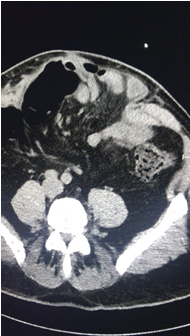|
Abdominal wall - large ventral
hernias and incisional hernia:
(Recent developments - the use of imaging and
Botox injection)
Morry Brygel
Correspondence:
Professor Brygel
Melbourne Hernia Clinic
Melbourne
Australia
Email: mbrygel@netspace.net.au;
www.hernia.net.au
Introduction
Both ultrasound
and CT scanning have become increasingly useful
in the diagnosis and management of conditions
of the abdominal wall, particularly hernias.
Large ventral, incisional and recurrent hernias
remain a significant challenge despite the introduction
of mesh, component separation and laparoscopy.
Recurrence rates remain between 7% and 48%.
Abdominal wall masses may include subcutaneous
lipomas or rarely, muscular tumours. Ultrasound
may also diagnose ruptures of the rectus muscle
from either a direct blow or excess effort or
straining.
Hernias
Imaging
Both ultrasound and CT are used in the diagnosis
and management of hernias.
An ultrasound can demonstrate small Spigelian
hernias which are often concealed. These can
even be confused with an inguinal hernia. They
are not as useful for very large hernias as
it is difficult to outline the whole defect.
The ultrasound can be used in the assessment
of umbilical and epigastric hernias. The size
of the defect may be relevant in deciding whether
a mesh is used, thus facilitating an informed
consent discussion regarding the use of mesh.
It may also detect additional small epigastric
hernias ensuring that they are not missed at
surgery. An emerging use of ultrasound is as
a guide to the placement of Botox, in the management
of large ventral or incisional hernias.

Incisional hernia coronal view

This is a ct sagittal view demonstrating
a large incisional hernia extending almost to
the symphyses pubis.
CT SCANS
CT scans are most useful for very large ventral
or incisional hernias, as they accurately locate
and measure the number and size of the defects.
This is not feasible with ultrasound alone.
It is useful for the surgeon to pre-operatively
anticipate the size of the mesh required and
the complexity of the operation.
The CT also defines the contents of the hernia,
be it omentum, bowel or fluid. It may also be
used to exclude other intra abdominal coexistent
pathology.
Botox
A recent important innovation is the use of
Botox in the management of large ventral hernias.
Botox is injected under ultrasound control into
the bellies of the three lateral abdominal wall
muscles on each side, two weeks prior to surgery.
The Botox relaxes these muscles and enables
apposition of the rectus muscles more easily.
The loss of domain which can impair respiration
once the hernia is closed is also minimized
because of the flaccidity of the lateral abdominal
wall muscles from the Botox. This lasts for
about 6 weeks. This flaccidity also reduces
the risk of recurrence.
It also reduces the levels of post operative
pain which is often significant even with laparoscopic
repair. The effect lasts for a many weeks further
reducing the risk of recurrence
In Botox research the scan shows the 3 lateral
abdominus muscles are lengthened considerably
. This reduces the size of the defect to be
closed.
The Melbourne Hernia
Clinic has an educational site devoted to hernias
and office surgery. A/Prof Maurice Brygel also
conducts skills workshops for GPS - for details:
visit www.hernia.net.au
| 
